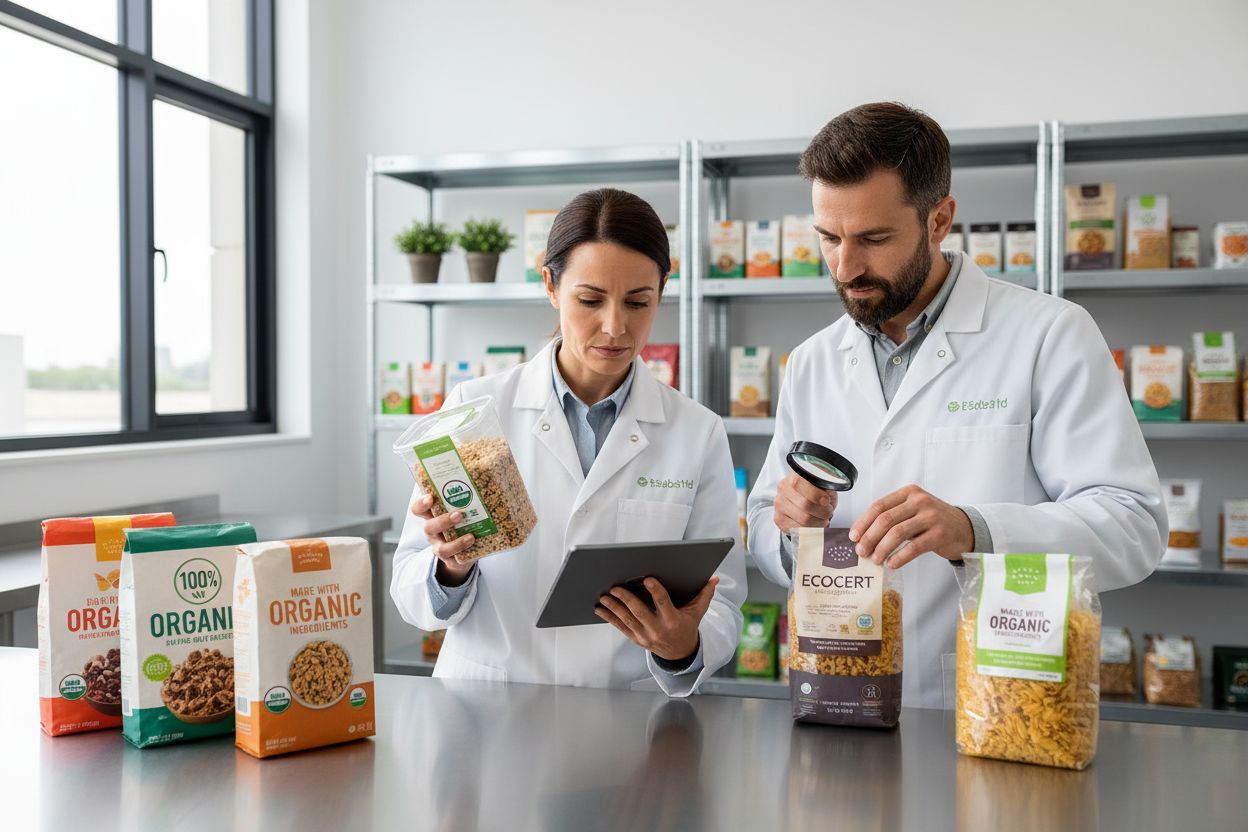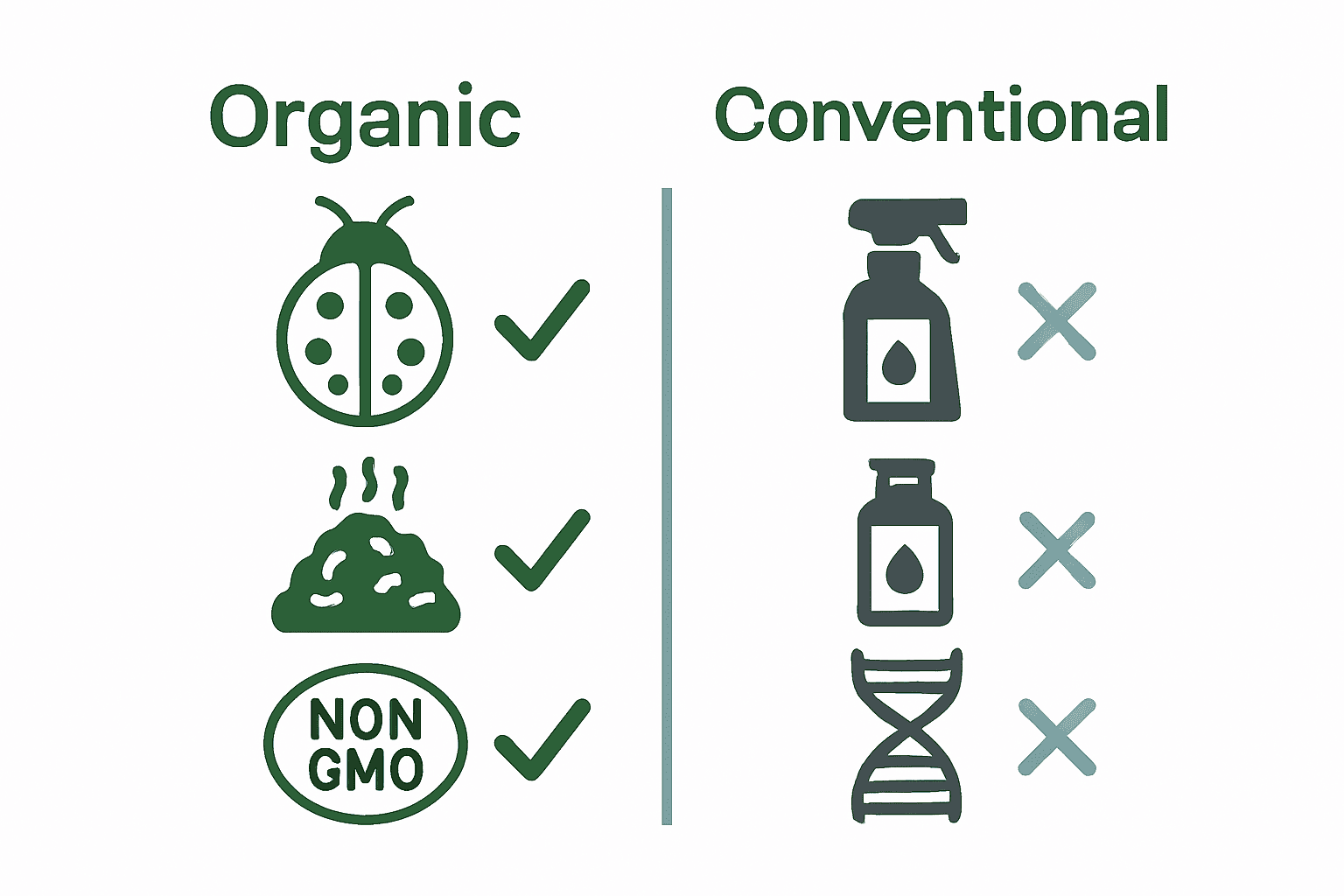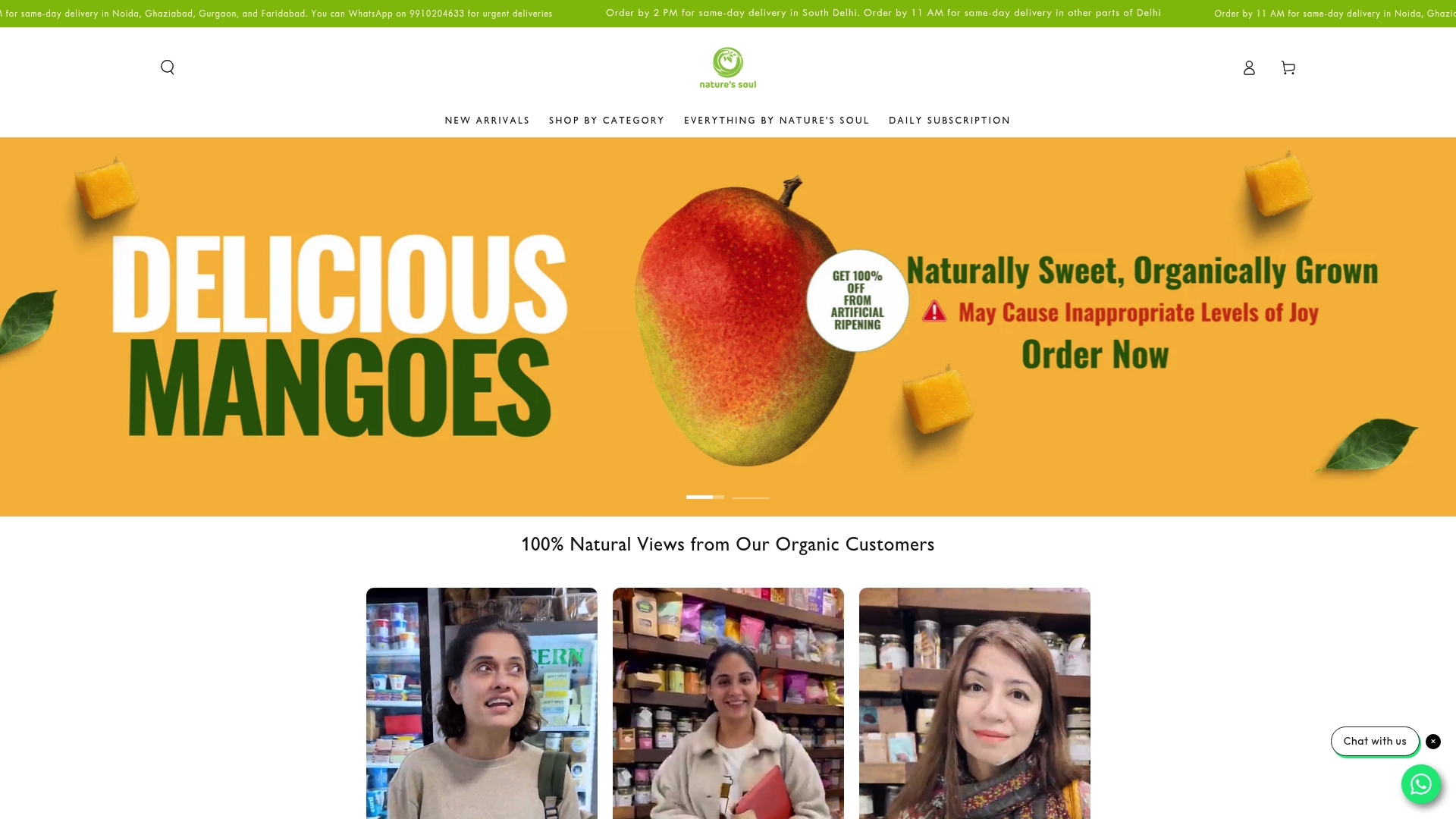Over 80 percent of families in the United States have purchased organic products at least once, reflecting a major shift in how people choose their food. As concerns over health, environmental impact, and food safety keep growing, the terms organic and conventional have become central in daily shopping decisions. Understanding the real differences between these approaches helps you select foods that fit your values, health goals, and budget.
Key Takeaways
| Point | Details |
|---|---|
| Organic vs. Conventional | Organic products prioritize sustainable practices without synthetic chemicals, while conventional farming maximizes yield with industrial methods. |
| Certification Standards | The USDA Organic Seal guarantees that products meet rigorous organic standards, enabling informed consumer choices. |
| Health Benefits | Organic foods often lead to lower pesticide exposure and may positively influence cardiometabolic health. |
| Market Trends | The organic market is expanding, with narrowing price gaps making organic products more accessible to consumers. |
Table of Contents
- Defining Organic And Conventional Products
- Certification Standards And Labeling Differences
- Production Methods And Ingredient Sourcing
- Health, Nutrition, And Safety Impacts
- Environmental Effects And Sustainability Issues
- Cost, Availability, And Market Trends
Defining Organic and Conventional Products
When we talk about organic and conventional products, we’re diving into two fundamentally different approaches to food production. According to a comprehensive scientific review, organic farming represents a holistic agricultural method that strictly prohibits synthetic fertilizers, pesticides, feed additives, and genetically modified organisms (GMOs). Instead, these farms prioritise sustainable ecological technologies that work harmoniously with nature.
Conventional products, in contrast, operate under a more industrialised agricultural model. These production methods typically allow the use of synthetic chemicals, artificial fertilisers, and may include GMO crop varieties. While conventional farming focuses on maximising yield and efficiency, organic farming emphasises environmental sustainability and natural production processes.
The key distinguishing features between organic and conventional products include:
- Production Methods: Organic uses natural pest control and fertilisation; conventional allows synthetic interventions
- Chemical Usage: Organic prohibits synthetic pesticides; conventional permits their application
- Environmental Impact: Organic practices aim to minimise ecological disruption; conventional methods may have broader environmental consequences
- Nutritional Considerations: Some studies suggest organic products might have marginally different nutritional profiles
Read more about choosing organic gluten-free foods to understand how these principles translate into practical food selection for health-conscious consumers.
Certification Standards and Labeling Differences
Navigation through organic product labels can feel like deciphering a complex code. In the United States, the Organic Foods Production Act established robust guidelines that define precise categories of organic certification. According to official documentation, these categories range from “100% organic” to “organic” and “made with organic ingredients”, each carrying specific regulatory requirements.
The USDA Organic Seal serves as a critical marker for consumers, signalling that products meet stringent national standards. This seal strictly prohibits the misuse of the term “organic”, ensuring transparency and preventing misleading marketing claims. International certification bodies like ECOCERT, founded in France, play an equally significant role in maintaining global organic standards, inspecting and certifying products across food, cosmetics, and textiles in over 80 countries.
Key labeling distinctions include:
- 100% Organic: Contains exclusively organic ingredients
- Organic: At least 95% organic ingredients
- Made with Organic Ingredients: Contains minimum 70% organic components
- Non-organic Ingredients: Allowed under specific regulated conditions
Consumers should look for official certification marks and understand these nuanced categories to make informed purchasing decisions. The complexity of these standards reflects the comprehensive approach to maintaining organic integrity across global markets.

Production Methods and Ingredient Sourcing
Organic farming represents a sophisticated agricultural approach that fundamentally differs from conventional production methods. According to academic research, organic practices prioritise natural ecosystem management through techniques like crop rotation, natural fertilization, and avoiding chemical-based growth stimulants and antibiotics. This holistic approach stands in stark contrast to conventional farming, which typically relies on synthetic inputs to maximize agricultural yields.
Recent scientific studies have highlighted remarkable environmental benefits of organic production techniques. A groundbreaking research demonstrated that methods such as alternate wetting and drying, combined with organic fertilizers, can significantly reduce greenhouse gas emissions and heavy metal levels in crops like rice. Remarkably, these sustainable practices achieve this without compromising agricultural productivity - a critical consideration for global food security.
Key distinctions in production methods include:
Here’s a comparison of organic and conventional production features:
| Feature | Organic Farming | Conventional Farming |
|---|---|---|
| Soil Management | Natural compost Biological fertilisers |
Synthetic chemical fertilisers |
| Pest Control | Natural predators Ecological barriers |
Chemical pesticides |
| Animal Husbandry | No routine antibiotics No growth hormones |
Antibiotics and hormones allowed |
| Genetic Modification | GMOs strictly prohibited | GMOs permitted |
- Soil Management: Organic uses natural compost and biological fertilizers; conventional uses synthetic chemical fertilizers
- Pest Control: Organic employs natural predators and ecological barriers; conventional uses chemical pesticides
- Animal Husbandry: Organic prohibits routine antibiotics and growth hormones; conventional permits these interventions
- Genetic Modification: Organic strictly excludes genetically modified organisms; conventional allows GMO crop varieties

Learn more about sustainable agriculture practices that are transforming our approach to food production and environmental stewardship.
Health, Nutrition, and Safety Impacts
The debate surrounding organic versus conventional food’s health impacts is nuanced and complex. A comprehensive systematic review examining 147 scientific studies revealed a surprising insight: there is no universal nutritional superiority for organic products. Specifically, about 29% of comparisons showed significant differences, while 42% demonstrated no nutritional variation between organic and conventional foods.
However, pesticide exposure emerges as a critical differentiator. According to recent systematic research, organic consumption is associated with reduced pesticide exposure and potentially lower cardiometabolic risk factors. These findings suggest potential health benefits, particularly in managing risks related to obesity, hypertension, and diabetes. While the evidence remains inconclusive regarding cancer risk and precise nutrient values, the research indicates a promising trajectory for organic food’s health potential.
Key health considerations include:
- Pesticide Reduction: Organic foods demonstrate lower chemical residue levels
- Metabolic Health: Potential improvements in cardiometabolic risk markers
- Chemical Exposure: Minimised interaction with synthetic agricultural chemicals
- Long-term Wellness: Emerging research suggests potential preventative health benefits
Discover more about clean ingredients and their impact to make informed dietary choices that support your overall health and well-being.
Environmental Effects and Sustainability Issues
Organic farming represents more than a food production method; it’s a comprehensive approach to environmental stewardship. Recent scientific research has revealed remarkable insights into how organic agricultural practices can significantly mitigate environmental challenges. A groundbreaking study on rice production demonstrated that techniques like alternate wetting and drying can substantially reduce greenhouse gas emissions, specifically methane levels, while simultaneously lowering heavy metal contamination in agricultural produce.
Modeling studies exploring aquifer water quality have unveiled complex interactions between farming practices and environmental sustainability. These investigations highlight critical policy-relevant trade-offs between ecological preservation and social welfare. Organic farming’s approach goes beyond simple chemical reduction, focusing on holistic ecosystem management that considers long-term environmental impacts and agricultural productivity.
Key environmental considerations include:
- Greenhouse Gas Reduction: Organic methods can significantly lower methane emissions
- Water Quality: Reduced chemical fertilizer usage improves groundwater health
- Soil Biodiversity: Natural farming techniques support more robust ecological systems
- Heavy Metal Mitigation: Organic practices help reduce toxic element accumulation in food chains
Learn more about sustainable agriculture practices that are reshaping our approach to environmental conservation and food production.
Cost, Availability, and Market Trends
The organic product market has undergone a remarkable transformation in recent years, shifting from a niche segment to a mainstream consumer choice. What was once considered a premium option has now become increasingly accessible, with more retailers, supermarkets, and local markets expanding their organic product ranges. This growing availability reflects a significant shift in consumer preferences towards healthier, more sustainably produced foods.
Pricing remains a critical factor in organic product adoption. While organic products historically carried a substantial price premium, market competition and increased production efficiency have gradually narrowed this gap. Consumers are now finding more affordable organic options across various product categories, from fresh produce to packaged goods. The price differential has shrunk from sometimes 50-100% more expensive to a more manageable 10-30% in many product categories.
Key market dynamics include:
- Consumer Awareness: Growing understanding of health and environmental benefits
- Retail Expansion: Increased organic product range in mainstream grocery stores
- Price Convergence: Narrowing price gap between organic and conventional products
- Diverse Product Categories: Organic options now available across multiple food and lifestyle segments
Discover more about healthy eating strategies that can help you make informed, budget-friendly organic choices.
Ready to Experience the Difference Between Organic and Conventional?
Have you ever felt overwhelmed by confusing labels, concerns about chemical exposure, or uncertainty when it comes to choosing between organic and conventional products? This guide has shown how cleaner ingredients, reduced pesticide use, and ethical production are crucial for both your health and the environment. Yet, sourcing genuinely organic and natural products across a wide range still feels like a challenge for many.

Take the guesswork out of healthy living today. Explore our range at Natures Soul Shop, where you will find trusted options in fruits, vegetables, meats, dry grocery, dairy, vegan, gluten free, home care, and skin care—each featuring carefully selected, clean ingredients. Take the next step in your wellness journey by discovering what clean ingredients truly mean for your daily choices or browse practical tips for selecting organic gluten-free foods. Choose better for your body and the planet—start shopping with confidence while stocks last.
Frequently Asked Questions
What are the main differences between organic and conventional products?
Organic products are produced without synthetic fertilizers, pesticides, and GMOs, prioritizing sustainable practices. Conventional products allow synthetic chemicals and may include GMOs, focusing on maximum yield and efficiency.
How do organic certification standards work?
Organic products must meet strict certification standards governed by regulations that classify products as ‘100% organic,’ ‘organic,’ or ‘made with organic ingredients,’ each with specific requirements for organic content.
Are organic products healthier than conventional products?
While there’s no definitive consensus on nutritional superiority, organic products generally have lower pesticide residues, which may lead to potential health benefits. However, studies indicate that actual nutrient differences are not universally significant.
How does organic farming impact the environment compared to conventional farming?
Organic farming methods can significantly reduce greenhouse gas emissions, improve water quality, and enhance soil biodiversity, whereas conventional practices often involve higher chemical use, which can negatively impact the environment.
Recommended
- 7 Essential Tips for Choosing Organic Gluten Free Foods – naturessoulshop
- Understanding What Are Clean Ingredients and Their Benefits – naturessoulshop
- Understanding Sustainable Agriculture Practices for a Better Future – naturessoulshop
- Master Zero Waste Grocery Shopping: A Practical Guide – naturessoulshop






